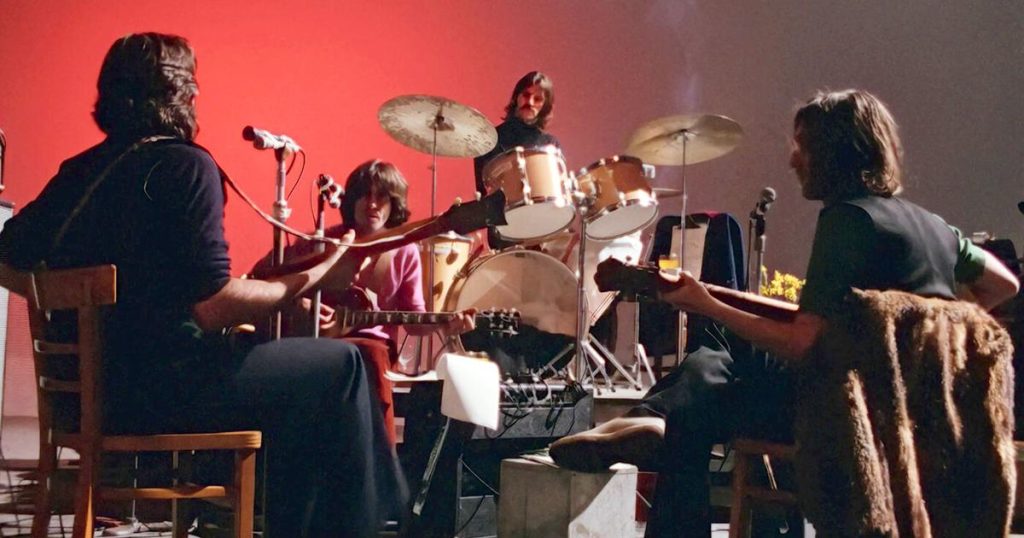It’s a great time to be a Beatles fan with a subscription to Disney+. The release of Peter Jackson’s “The Beatles: Get Back” documentary series in 2021 was the start of the relationship that has continued to blossom and pay dividends ever since.
In 2022, the documentary “If These Walls Could Sing” was released on Disney+, giving viewers a behind-the-scenes history tour of Abbey Road Studios (formerly EMI Recording Studios), including all-star interviews and backstage access to the premises. Directed by Mary McCartney (daughter of Paul), there of course were plenty of Beatles moments featured alongside the London Symphony Orchestra, Jimmy Page, Kate Bush, Elton John and Shiley Bassey.
Then in 2023, with the release of the Beatles’ final single, “Now and Then,” a mini-doc about the song’s history and recording process, again utilizing some of the techniques from Jackson’s documentary, premiered on Disney+.
And now we’ve come full circle. The 1970 documentary “Let It Be,” the 1969 recordings leading to the album of the same name, has been remastered, restored and re-released for the first time after not being officially available on home video since the 1980s.
The original film by Michael Lindsay-Hogg is the perfect companion to Jackson’s new documentary, which took 55 hours of footage filmed for “Let It Be” and restored and re-edited it. As Peter Jackson recently told Rolling Stone magazine, “‘Let It Be’ is the climax of ‘Get Back,’ while ‘Get Back’ provides a vital missing context for ‘Let It Be.’”
The film observes John, Paul, George and Ringo Starr from a “fly on the wall” perspective, without narration, scene titles or talking-head interviews with the main subjects. The first portion of the film shows the band rehearsing on a sound stage at Twickenham Film Studios before moving to Apple Corps headquarters and concluding with the rooftop concert.
For years after its release, “Let It Be” received mixed and even disappointing reviews with many people connecting it with the band’s breakup just a month earlier. The album was released the week before, but several of the Beatles had already released solo work, while the lead singles of “Get Back” and “Let It Be” had also been released and heard by everyone and their mother.
The thing is, the actual content of the film itself is pretty chipper and lighthearted. Yes, there are a couple of moments of head-butting, but the overall vibe is of four lads goofing around for a few weeks. If the film had been a holiday 1969 release as originally planned, long before the band’s official breakup and as the place people heard many of these songs for the first time, I wager it would have been much better received.
But after the nearly eight-hour Peter Jackson documentary, this 81-minute original seems more like an extended preview or a “greatest hits” version of a much more interesting story that isn’t complete. Nevertheless, it’s so fascinating watching the greatest band of all time at work and behind the scenes.
The generously fast-paced editing — cut down from an original two-hour-plus version — leads to a lot of great moments, like the Fab Four rehearsing a song for the first time before immediately cutting to them a few days later with the track sounding almost exactly like the final album version.
Unfortunately, that short run time means the editing loses a lot of the story that’s explained in “Get Back.” Here, George doesn’t quit the band for a few days and before the other three convince him to come back. There’s no reason why they leave Twickenham after a week — they’re suddenly at Apple rehearsing. Then suddenly Billy Preston is here playing keyboards with no “hi, how are ya?” and then suddenly they’re on the roof playing their concert. It’s cool to see, but it leaves the viewer with a lot of questions.
The Peter Jackson-ification of the remaster is excellent with both the cinematography and sound retaining some of their era look and feel — like the restored full-screen 4:3 ratio rather than the cropped widescreen version — but cleaned up to work on today’s 4K TVs. You can tell it’s 1969, but it doesn’t look like a bootleg VHS copy bought off eBay, and it’s about bloody time.
